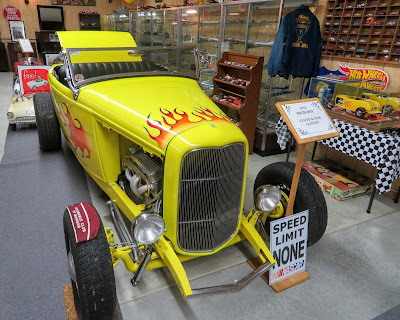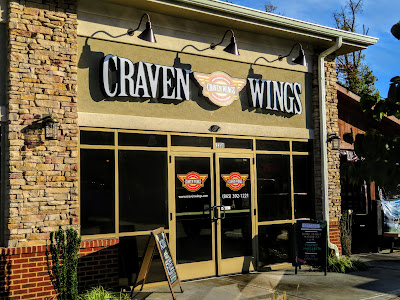This is my final post about our interesting…actually mind boggling…visit to Ye Ole Carriage Shop in Spring Arbor Michigan. Although there are a couple of automobiles shown below, my overall objective with this posting was to show some additional representative items from the impressive variety of antiques and collectibles on display in this small town museum. Judi and Lloyd Ganton have created a great museum and, as you’ll learn at the end of this posting, they’re planning to preserve the history they’ve saved so that future generations can understand and appreciate the past.
What an attractive Sinclair Aircraft fuel sign! Copies can be purchased by anyone for less than $50.00 but the rare porcelain double-sided signs like this one are another story altogether. I found a record of one like this that sold in 2021 for $19,800.
Sinclair
Oil is over 100 years old and despite mergers, buyouts, etc. there still are
over 1,400 independent Sinclair gas stations across 30 states. Sinclair anticipated the need for 100-octane
gasoline as early as 1937 and, when WWII began, the company was able to quickly
expand production of aviation fuel.
Based in Sinclair Wyoming, the company does produce aviation fuel, but nowadays its for jet aircraft.
In this photo there is a Corvair and I’m not sure what the red sports car is…but take note of the plethora of original signs and those fantastical gas pumps. I especially love the ‘Mobilgas’ pump with the built-in display case for other automotive products. That Mobilgas Pegasus flying horse is worth noting as well. I found one that sold back in 2014 for over $6,000 but I’m not sure how big it was.
Note: I was surprised to learn that Pegasus was
originally a symbol used by the Standard Oil Company of New York.
These Burger Chef signs bring back a lot of memories! When I was attending Michigan State University, I drove a taxi in Jackson Michigan whenever we had a break from school…Christmas, spring break and in the summer. In those days, I basically rented the cab and had to make a certain amount to pay the ‘rent’ and buy gas. Everything else was mine to keep…
The
Burger Chef in Jackson was located next to the Greyhound Bus Depot and one of
the quickest ways to make enough to pay rent and gas was to pick up a couple of
fares from the bus station and run them out to the Southern Michigan Prison so
they could visit their family members or significant others. That prison run was a flat amount per passenger in each direction…
In any
case, I’d arrive at the bus station a bit before the bus was due and I’d pick
up lunch from Burger Chef…usually 2 flame broiled double cheeseburgers and a vanilla
shake. I loved those burgers! The company was founded in 1954 and at one
point Burger Chef operated 1,200 locations.
The last Burger Chef closed in 1996.
This room features motorcycles, toy trucks and cars, an old outboard motor, including more oil/gas company products and, of course signs. The Motorcycles include a 1949 2-cylinder Harley-Davidson and a 1947 Indian as well as one from Sears. The Sears model looks like it dates back to 1913 or 1914. The top of the line model in 1914 sold for $197.00.
Moving on we came to this room full of bicycles, toy fire apparatus and more trucks…from floor to ceiling. (Keep in mind that this series of photos only shows one end of the rooms) The bicycles include a classic Schwinn and an equally classic Columbia. I noted that one of the older units had belonged to a local Spring Arbor resident. Locals have continued to donate items to Ye Ole Carriage Shop over the years.
Schwinn
was in business from 1895 until 1992 when it went into bankruptcy. It is now owned by Pacific Cycle, a Dutch
Company.
Columbia
made bicycles from 1877 until the recession of 1991. The company has started making bicycles
again…the Superb 5-Star Cruiser Bike…old style with balloon tires. A new men’s “Cruiser” can be purchased at
Dunham’s Sports for $194.97.
The primary focus in this photo is the 1932 “High Boy” hot rod. But, looking beyond the High Boy, one can see hundreds of toy autos as well as showcase after showcase full of model aircraft.
The Ford
High Boy Hot Rod is called a ‘high boy’ because the body is mounted on top of
the chassis and another feature is the lack of fenders. These 1932 Ford Hot Rods are considered to be
the very first of the hot rods. Prices
for a 1932 High Boy in excellent condition range from $65,000 up to
$700,000…quite a range.
Variety is evident with this photo. At the right there is a 2-man ‘cutter’ or sleigh built by the Jackson Vehicle Company in 1900. I’ve never had the experience of riding in a horse drawn sleigh…
Just to
the left of the sleigh/cutter sits a 1959 Cushman 1-cylinder Trail Master. Cushman, originally based in Lincoln
Nebraska, began making “Auto-Glide” scooters in 1936 as a way to increase the
company’s sales of Husky engines during the Great Depression. Cushman scooters were widely utilized by the
United States military during WWII.
After the war, they served as an alternative to automobiles. Cushman produced 15,000 scooters in
1958. The company stopped building scooters
in 1965.
Yet another horse drawn conveyance from the early part of the 1900s. This one man buggy was built in 1905 in Jackson Michigan by the Ames-Dean Carriage Company. Prior to the dominance of the newfangled automobiles, Jackson buggy and carriage business produced thousands of vehicles every year. Major players in this ‘horse before the cart’ business included the Fuller Buggy Company, the Jackson Carriage Company and of course, the Ames-Dean Carriage Company. Many of these carriage/buggy companies morphed into auto makers...
So you’re not into automobiles, toy cars and trucks, buggies, motorcycles, model airplanes or automotive related items… How about genuine Coca- Cola products, signage and souvenirs? One of our last stops was a room that was loaded from floor to ceiling with Coca-Cola antiques and collectibles. There are 6.5 oz. Coke bottles and cans from everywhere, advertising posters, promotional items such as thermometers and clocks, old time Coke signs, coolers, Coke machines, toys, trays and much more.
Of course there just has to be a soda counter available to go with all that Coca-Cola memorabilia! Of course, the Coke collection continued here as well. This room is used for parties and meetings. Of note, the Board of Directors for Ye Ole Carriage Shop holds their meetings in this room with its soda counter and the amazing collection of Coca Cola items…
If you’re old enough to remember what kitchens looked like in the late 1940s and at least the first part of the 1950s, this kitchen may look very familiar to you. My better half thought that it looked just like her family kitchen when she was young. In any case, this essentially was Judi Ganton’s family kitchen. She’s ‘recreated’ the space here in the museum. I wouldn’t be surprised if that General Electric refrigerator still works. They built them to last back in the day…
Ah, this gathering of memorabilia represents yet another family memory for yours truly. Jacobson’s was an upscale American regional department store chain. It was based in Jackson Michigan and it primarily operated in Michigan and Florida. They also had stores in Ohio, Indiana, Kentucky and Kansas. This was my mother’s favorite store for both clothing selection and service. Even after she stopped going out shopping, they would shop for her and deliver what she wanted. Jacobson’s entered bankruptcy in 2002 after 164 years of service to its customers.
Even I don’t remember having an old Philco television. To be honest, I don’t remember our family’s first TV. My early memories are more radio related. We listened to “The Shadow”, Red Skelton, Burns and Allen, Lassie, Dragnet…and of course Detroit Tiger Baseball.
I do know
that I was about the last person in our neighborhood to hold onto my black and
white console TV, finally giving it up in the early 1970s. As for that Philco television, I believe that
it is a Philco Predicta, a black and white TV chassis style. This iconic design had the picture tube (CRT)
separated from the rest of the cabinet.
Another trip down memory lane…a 1958 – 1959 Montgomery Ward catalog. My last position in retailing per se was with Montgomery Ward. It all came to a crashing halt when the company closed all of its stores in 2001. Although the catalog operations had closed down when I joined the company, I loved wandering through the cavernous former Chicago catalog warehouse. I do have a number of Montgomery Ward collectibles but I haven’t decided what to do with them yet…
Why did I include this photo of a toy/tin airplane? Because if you look again you’ll see that it’s really an unusual and rare child’s pedal car.
Yes…Ye Ole Carriage Shop has the largest collection of children’s pedal cars that I’ve ever seen. The walls of yet another room are covered with these once popular outdoor toys. These days, pedal cars are still being built but they aren’t as popular as they used to be. Many kids with child-size vehicles today, ‘drive’ battery powered versions. The second photo shows an assortment of the oldest pedal cars owned by Ye Ole Carriage Shop.
Child-size
pedal cars became very popular toys in the 1920s and 1930s. They were mostly toys form wealthy families
as they were expensive. First on the
marketplace in the 1890’s, early pedal cars were made of wood. It wasn’t too long though before manufacturers
began rolling metal pedal cars off the assembly lines. Many were as well equipped as were their full
size ‘adult’ counterparts. In addition
to pedal automobiles and airplanes, there was a wide assortment of trucks,
buses, trains, boats, earth moving equipment and tractors for the discerning young pedal car
enthusiast.
The first
American company to build these wheeled toys was the Garton Toy Company. It was founded in 1887. By the 1930s American National was the
largest maker of kid’s vehicles.
American National exported pedal cars to about 30 countries. With the onset of WWII, steel was needed for
the war effort and production of pedal cars ceased. In the 1950s and 1960s, the business
restarted but plastic and safety standards brought an end to wide-spread metal
car production.
Collection
of pedal cars isn’t for the faint-hearted.
An early Gendron Buick pedal car sold for $12,000 in the spring of
2018. I found an ad on eBay for a rare 1926
Gendron pedal car airplane ($3,225.00). To
view a plethora of imaginative pedal cars…70 in all…that were sold in auction
in 2015, just go to https://newatlas.com/70-vintage-pedal-cars-lead-to-record-sale-of-automobilia-collectibles/35758/.
And so
ends our exploration of Ye Ole Carriage Shop in Spring Arbor Michigan. Thanks to Judi Ganton for serving as
informative tour-guide. Ye Ole Carriage
Shop is an amazing private collection!
The good news for future generations is that Judi and Lloyd have set up
a trust to ensure that the collection is maintained and available for many
years to come. To learn more about Ye
Ole Carriage Shop, you can just go to: https://www.yeolecarriageshop.com/.
Just
click on any of the photos to enlarge them…
Thanks
for stopping by for a visit!
Take
Care, Big Daddy Dave

















































